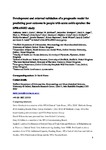Development and external validation of a prognostic model for predicting poor outcome in people with acute ankle sprains: the SPRAINED study.
| dc.contributor.author | Keene, D | |
| dc.contributor.author | Sclussel, M | |
| dc.contributor.author | Thompson, J | |
| dc.contributor.author | Hagan, D | |
| dc.contributor.author | Williams, M | |
| dc.contributor.author | Byrne, Chris | |
| dc.contributor.author | Goodacre, S | |
| dc.contributor.author | Cooke, M | |
| dc.contributor.author | Gwilym, S | |
| dc.contributor.author | Hormbrey, P | |
| dc.contributor.author | Bostock, J | |
| dc.contributor.author | Haywood, K | |
| dc.contributor.author | Wilson, D | |
| dc.contributor.author | Collins, G | |
| dc.contributor.author | Lamb, S | |
| dc.date.accessioned | 2018-09-03T10:52:07Z | |
| dc.date.available | 2018-09-03T10:52:07Z | |
| dc.date.issued | 2018-11 | |
| dc.identifier.issn | 1366-5278 | |
| dc.identifier.uri | http://hdl.handle.net/10026.1/12219 | |
| dc.description.abstract |
Background Ankle sprains are very common injuries. Although recovery can occur within weeks, around a third of patients have longer-term problems. Objectives To develop and externally validate a prognostic model for identifying people at increased risk of poor outcome after an acute ankle sprain. Design Development of a prognostic model in a clinical trial cohort dataset and external validation in a prospective cohort study. Setting Emergency departments in the UK. Participants Adults with an acute ankle sprain (within 7 days of injury). Sample size There were 584 clinical trial participants in the development dataset and 682 recruited for the external validation study. Predictors Candidate predictor variables were chosen based on availability in the clinical data set, clinical consensus, face-validity, a systematic review of the literature, data quality and plausibility of predictiveness of the outcomes. Main outcome measures Models were developed to predict two composite outcomes representing poor outcome. Outcome 1 was the presence of at least one of the following symptoms at 9 months after injury: persistent pain, functional difficulty or lack of confidence. Outcome 2 included the same symptoms as outcome 1 with the addition of recurrence of injury. Rates of poor outcome in the external dataset were lower than in the development dataset, 7 vs. 20% for outcome 1 and 16 vs. 24% for outcome 2, respectively. Analysis Multiple imputation was used to handle missing data. Logistic regression models, together with multivariable fractional polynomials, were used to select variables and identify respective transformations of continuous predictors that best predicted the outcome based on a nominal alpha of 0.157, chosen to minimise over fitting. Predictive accuracy was evaluated by assessing model discrimination (c-statistic) and calibration (flexible calibration plot). Results Performance of the prognostic models in development dataset: Outcome 1 model combined c-statistic across the 50 imputed data sets was 0.74 (95%CI 0.70 to 0.79), with good model calibration across the imputed data sets. Outcome 2 model combined c-statistic across the 50 imputed data sets was 0.70 (95%CI 0.65 to 0.74), with good model calibration across the imputed data sets. Updating these models, which used baseline data collected at the emergency department, with an additional variable at 4 weeks after the injury (pain when bearing weight on the ankle) improved the discriminatory ability (c-statistic 0.77; 95%CI 0.73 to 0.82 for outcome 1 and 0.75; 95%CI 0.71 to 0.80 for outcome 2) and calibration of both models. Performance of the models in the external dataset: The outcome 1 model combined c-statistic across the 50 imputed data sets was 0.72 (95%CI 0.66 to 0.79), with a calibration plot intercept of -0.71 (95%CI -0.98 to 0.44) and slope of 1.13 (95% CI 0.76 to 1.50) across the imputed data sets. The outcome 2 model combined cstatistic across the 50 imputed data sets was 0.63 (95%CI 0.58 to 0.69), with calibration plot intercept of -0.08 (95%CI -0.27 to 0.11) and slope of 1.03 (95%CI 0.65 to 1.42) across the imputed data sets. The updated models with the additional pain variable at 4 weeks had improved discriminatory ability over the baseline models but not better calibration. Conclusions The SPRAINED prognostic models performed reasonably, and showed benefit when compared to not using any model, so may assist clinical-decision making when managing and advising ankle sprain patients in the emergency department setting. The models use predictors that are simple to obtain. Limitations Data used to develop the prognostic models were from a randomised controlled trial so were not originally intended to fulfil this aim. However, it was the best dataset available, with data on the symptoms and clinical events of interest. Future work Further model refinement, including re-calibration or identifying additional predictors may be required. Impact of implementing and using either model in clinical practice, in terms of acceptability and uptake by clinicians, and on patient outcomes should be investigated. Study registration Current Controlled Trials ISRCTN12726986 Funding details NIHR Health Technology Assessment programme. | |
| dc.language.iso | en | |
| dc.publisher | NIHR Journals Library | |
| dc.title | Development and external validation of a prognostic model for predicting poor outcome in people with acute ankle sprains: the SPRAINED study. | |
| dc.type | journal-article | |
| plymouth.issue | 64 | |
| plymouth.volume | 22 | |
| plymouth.journal | Health Technology Assessment | |
| plymouth.organisational-group | /Plymouth | |
| plymouth.organisational-group | /Plymouth/Faculty of Health | |
| plymouth.organisational-group | /Plymouth/Faculty of Health/School of Health Professions | |
| plymouth.organisational-group | /Plymouth/REF 2021 Researchers by UoA | |
| plymouth.organisational-group | /Plymouth/REF 2021 Researchers by UoA/UoA03 Allied Health Professions, Dentistry, Nursing and Pharmacy | |
| plymouth.organisational-group | /Plymouth/Research Groups | |
| plymouth.organisational-group | /Plymouth/Research Groups/Institute of Health and Community | |
| dcterms.dateAccepted | 2018-02-19 | |
| dc.rights.embargodate | 2019-2-15 | |
| dc.rights.embargoperiod | Not known | |
| rioxxterms.licenseref.uri | http://www.rioxx.net/licenses/all-rights-reserved | |
| rioxxterms.licenseref.startdate | 2018-11 | |
| rioxxterms.type | Journal Article/Review |


